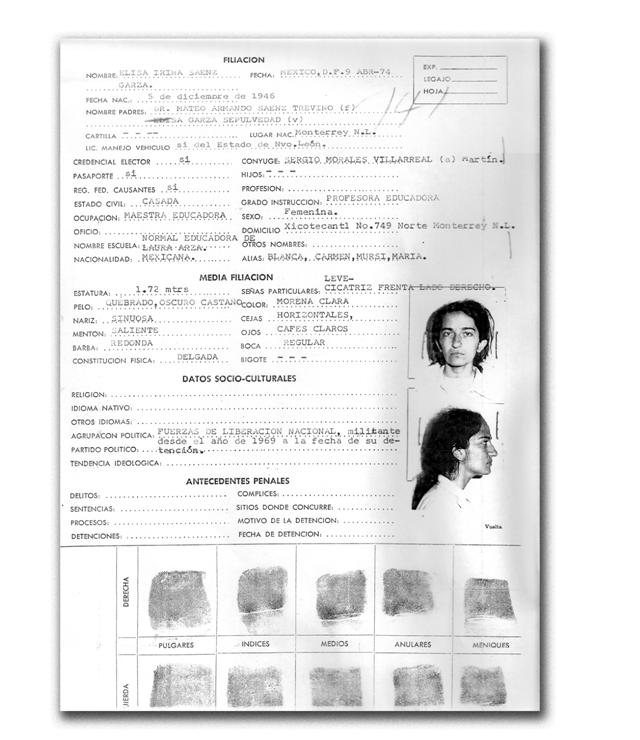
Early Life and Education
Elisa Irina Sáenz Garza was born on December 5, 1946, in Monterrey, Nuevo León, to Dr. Mateo Armando Sáenz Treviño and Professor Elisa Garza Sepúlveda. Raised in an academic and civic-minded family, she pursued her education at Instituto Laurenz and Preparatoria No. 1 of the Universidad de Nuevo León. She later took a secretarial course in Spanish and enrolled at Normal de Educadoras «Laura Arce,» where she graduated as a kindergarten teacher in mid-1967.
She began her teaching career in 1966 at the Venustiano Carranza Kindergarten, where she worked until mid-1971. However, her path took a radical turn as she became involved in revolutionary politics, driven by the injustices of her time.
Political Awakening and Involvement in the FLN
In 1960, Elisa Irina got closer to her brother, Mario Alberto Sáenz Garza’s, circle of friends, who were engaged in political activism. Through her engagement she became involved in two major political organizations: The National Liberation Movement (MLN) and the Mexican Cuban Institute for Cultural Relations (IMCRC).
Elisa Irina quickly took on a leadership role in the IMCRC, handling its finances and later becoming its president. As a result of this, she traveled to Cuba in late 1968 and early 1969, where she deepened her understanding of the revolutionary struggle.
Although she was not among the founding members of the National Liberation Forces, Fuerzas de Liberación Nacional (FLN), she became the first woman to join the group in 1969. The FLN was a clandestine Marxist-Leninist guerrilla organization .
Her marriage to Raúl Sergio Morales Villarreal in September 1969 was not just a personal union but an ideological one, marking the first instance of a «revolutionary marriage» within the FLN, symbolizing her complete devotion to the cause.
Her Role in the FLN: Urban Networks and Clandestine Operations
Within the FLN, Elisa Irina played a crucial role in developing the organisation’s urban networks):
Between 1969-1970, she was responsible for the FLN’s urban network in Monterrey, Nuevo León, a key city in Mexico’s industrial sector and an area of significant revolutionary activity. Then between 1972-1973, she oversaw the FLN’s urban network in Villahermosa, Tabasco, continuing the group’s clandestine expansion.
Her responsibilities included: Coordinating recruitment and communication between urban cells, Managing logistical support for armed and clandestine operations, Securing financial resources for the movement.
By 1971, the Mexican government had discovered the FLN’s existence, forcing Elisa Irina into clandestinity at the age of 24. She remained in deep clandestinity for three years, as the FLN sought to evade state repression and strengthen its organisational infrastructure.
During this period, she married Raúl Pérez Gasque in December 1973, another FLN militant. As the only woman in her unit, she was initially relegated to «tasks appropriate for her gender», but she fought for and was ultimately allowed to undergo the same rigorous military training as her male counterparts.
The State’s Brutal Crackdown: The Dirty War Intensifies
Elisa Irina’s story is inseparable from the larger Dirty War (Guerra Sucia) that took place under President Luis Echeverría Álvarez (1970-1976). The Mexican government, in collaboration with a transnational private sector elites, and in line with US’ Operation Condor, launched a campaign of extermination against leftist revolutionaries, students, teachers and peasants.
Several key events shaped her final years:
- Elisa went into clandestinity a few days after the victory of the Monterrey student movement in 1971, which secured the autonomy of the University of Nuevo León and launched an offensive against the private sector in Monterrey. This forced Nuevo León’s governor, Eduardo A. Elizondo Lozano, to resign in early June 1971.
- June 10, 1971 (Jueves de Corpus Massacre): A paramilitary group called Los Halcones attacked student protesters in Mexico City, killing and disappearing dozens. This brutal repression solidified the belief among many young revolutionaries, including Elisa Irina, that armed struggle was necessary.
- September 11, 1973 (Coup in Chile): The overthrow and assassination of Salvador Allende sent shockwaves throughout Latin America, reinforcing the idea that imperialist authoritarianism would crush democratic means of transformation.
- September 17, 1973 (Assassination of Eugenio Garza Sada): A failed kidnapping attempt resulted in the death of a powerful Monterrey businessman. In response, the Mexican state and private industry unleashed a wave of terror, paramilitary groups, known as ‘Death Squads’, emerged in Monterrey and other cities across Mexico. These groups carried out assassinations in broad daylight, filling the streets with the bodies of students, teachers, and many civilians, instilling a deep fear across the nation.
Following this escalation of violence, the government intensified its hunt for FLN members. By early 1974, most of the organisation’s members had been captured, tortured, and executed. The Fuerzas de Liberación Nacional were the forerunners of the Ejército Zapatista de Liberación Nacional (Zapatista Army of National Liberation), an army of Indigenous people who had been oppressed for centuries and who, in 1994, rose up against the Mexican state and against the capitalist colonial system.
Arrest, Torture, and Forced Disappearance
In March 1974, Elisa Irina was captured in Santa Rita, Ocosingo, Chiapas, during «Operación Diamante,» a military operation aimed at eliminating the FLN. She was immediately transferred to Campo Militar No. 1 in Mexico City, one of the most notorious torture and execution centers during the Dirty War. Here she was tortured and executed by the Mexican military. She was 28 years old. Her case was officially recognised by the National Human Rights Commission (CNDH) in 2001, acknowledging her forced disappearance as a state crime.


